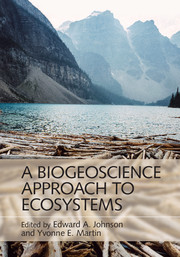Book contents
- Frontmatter
- Contents
- List of contributors
- Preface
- Miscellaneous Frontmatter
- 1 Introduction
- Part I Connecting Ecosystem and Geoscience Processes
- Part II Transport Processes and Conservation Budgets in Biogeoscience
- Part III Coupling Hillslope Geomorphology, Soils, Hydrology, and Ecosystems
- Part IV Coupling Fluvial and Aeolian Geomorphology, Hydrology/Hydraulics, and Ecosystems
- 10 Mechanisms of Flow and Sediment Transport in Fluvial Ecosystems: Physical and Ecological Consequences
- 11 Measuring the Hydraulic Landscapes of Stream-Dwelling Invertebrates for Ecological Research
- 12 Salt Marsh Ecosystems: Tidal Flow, Vegetation, and Carbon Dynamics
- 13 Coastal Dunes and Vegetation Dynamics
- 14 Biogeomorphic Ecosystems within Stressful and Disturbed Environments: A Focus on Termites and Pioneer Plants
- Index
- References
12 - Salt Marsh Ecosystems: Tidal Flow, Vegetation, and Carbon Dynamics
from Part IV - Coupling Fluvial and Aeolian Geomorphology, Hydrology/Hydraulics, and Ecosystems
Published online by Cambridge University Press: 27 October 2016
- Frontmatter
- Contents
- List of contributors
- Preface
- Miscellaneous Frontmatter
- 1 Introduction
- Part I Connecting Ecosystem and Geoscience Processes
- Part II Transport Processes and Conservation Budgets in Biogeoscience
- Part III Coupling Hillslope Geomorphology, Soils, Hydrology, and Ecosystems
- Part IV Coupling Fluvial and Aeolian Geomorphology, Hydrology/Hydraulics, and Ecosystems
- 10 Mechanisms of Flow and Sediment Transport in Fluvial Ecosystems: Physical and Ecological Consequences
- 11 Measuring the Hydraulic Landscapes of Stream-Dwelling Invertebrates for Ecological Research
- 12 Salt Marsh Ecosystems: Tidal Flow, Vegetation, and Carbon Dynamics
- 13 Coastal Dunes and Vegetation Dynamics
- 14 Biogeomorphic Ecosystems within Stressful and Disturbed Environments: A Focus on Termites and Pioneer Plants
- Index
- References
Summary
Introduction
Salt marshes are coastal wetlands located in the intertidal zone that are populated by halophytic vegetation. Although they occupy a relatively small percentage of the Earth's surface, they have been the focus of intense ecological and geomorphological research for several decades due to their importance in filtering pollutants, buffering against coastal storms, serving as nurseries for commercial fisheries, and storing carbon (Barbier et al., 2011). These ecosystems were among the first to be studied in an ecogeomorphic context due to the clear feedbacks between plant populations and landscape formation (e.g., Redfield 1972).
Salt marsh ecosystems are found on all continents except for Antarctica in mid to high latitude locations (Figure 12.1), giving way to mangrove swamps in subtropical and tropical climates. Radiocarbon dating of basal peats suggests that salt marsh ecosystems became widespread sometime between 4000 and 6000 years ago (Allen, 2000). Prior to this, sea level rise associated with post-glacial melt water and ocean expansion was too rapid for marsh establishment. Rates of eustatic sea level rise have increased over the twentieth and into the twenty-first century (Church and White, 2011), and there are now growing concerns that accelerating rates of sea level rise, combined with a decrease of sediment availability due to river damming could threaten marsh ecosystems. The threat of marsh loss has focused research into the balance between plant growth, hydrodynamics, and sedimentation in salt marsh ecosystems.
In this chapter we will examine the close coupling between plant vitality, hydrodynamics on marsh surfaces, and sedimentation. These components of the ecogeomorphic system on salt marshes form a continuous loop: marsh plants respond to edaphic factors such as salinity and depth in the tidal frame, and these are controlled by the hydrodynamics of tidally induced floods and sediment deposition rates. Plants interact with flows through drag, and can affect sedimentation rates through trapping. We begin by examining the factors that control plant productivity on coastal marshes.
- Type
- Chapter
- Information
- A Biogeoscience Approach to Ecosystems , pp. 407 - 434Publisher: Cambridge University PressPrint publication year: 2016
References
- 2
- Cited by



